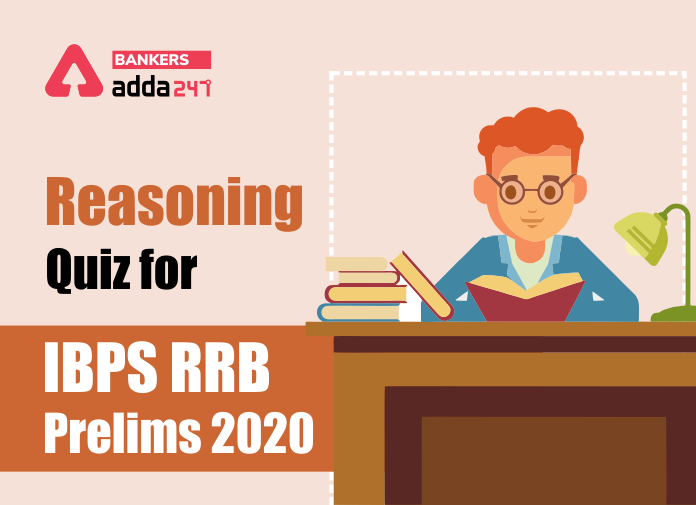Directions (1–5): In each of the question, relationships between some elements are shown in the statements(s). These statements are followed by conclusions numbered I and II. Read the statements and give the answer.
(a) If only conclusion I follows.
(b) If only conclusion II follows.
(c) If either conclusion I or II follows.
(d) If neither conclusion I nor II follows.
(e) If both conclusions I and II follow.
Q1. Statements: E ≤ R >T, G > R, K < R
Conclusions: I. K > T II. G > T
Q2. Statements: V >B >M > G > L < I ≤ J
Conclusions: I. V > J II. I ≥ B
Q3. Statements: O < M < Y > D, W<Y
Conclusions: I. Y> O II. W>O
Q4. Statements: I ≥ J> R > E < L, X < L, E > Y
Conclusions: I. I >E II. J>Y
Q5. Statements: P < W < Y ≥ I > V, Y > X
Conclusions: I. W < V II. Y> P
Directions (6-10): In these questions, relationship between different elements is shown in the statements. These statements are followed by two conclusions.
Mark answer as
Q6. Statement: Z≥O≥N=E>K, J>R=S≤N
Conclusion: I. N≥J II. J>E
(a) If only conclusion II follows.
(b) If only conclusion I follows.
(c) If both conclusion I and conclusion II follow
(d) If neither conclusion I nor conclusion II follows.
(e) If either conclusion I or conclusion II follows.
Q7. Statement: F≥R>I>E≤N, E=D≥T
Conclusion: I. F≥T II. R>T
(a) If neither conclusion I nor conclusion II follows.
(b) If only conclusion I follows.
(c) If both conclusion I and conclusion II follow
(d) If only conclusion II follows.
(e) If either conclusion I or conclusion II follows.
Q8. Statement: A<B≤C=D, E≥C≤F≤G
Conclusion: I. E>A II. G>A
(a) If only conclusion II follows.
(b) If either conclusion I or conclusion II follows.
(c) If both conclusion I and conclusion II follow
(d) If neither conclusion I nor conclusion II follows.
(e) If only conclusion I follows.
Q9. Statement: F≥R≤I>E≤N, E=D≥T
Conclusion: I. T>N II. N≥T
(a) If neither conclusion I nor conclusion II follows.
(b) If only conclusion I follows.
(c) If both conclusion I and conclusion II follow
(d) If only conclusion II follows.
(e) If either conclusion I or conclusion II follows.
Q10. Statement: A<B≤C=D, E≥C≤F≤G
Conclusion: I. G>A II. D>G
(a) If only conclusion I follows.
(b) If only conclusion II follows.
(c) If both conclusion I and conclusion II follow
(d) If neither conclusion I nor conclusion II follows.
(e) If either conclusion I or conclusion II follows.
Directions (11-15): In these questions, a relationship between different elements is shown in the statements. The statements are followed by two conclusions. Give answer
Q11. Statement: L≥B≥K, L≤T≤I, W<P≤L, I≥M<X
Conclusion: I. K<X II. W>M
(a) if only conclusion II is true.
(b) if only conclusion I is true.
(c) if neither conclusion I nor II is true.
(d) if either conclusion I or II is true.
(e) if both conclusions I and II are true.
Q12. Statement: D≤A≤M<S, Z<U≤D, Q>A≤Y<G
Conclusion: I. Z<Y II. S>Q
(a) if both conclusion I and II are true.
(b) if only conclusion I is true.
(c) if neither conclusion I nor II is true.
(d) if either conclusion I or II is true.
(e) if only conclusion II is true.
Q13. Statement: L≤T, W<P≤L≥B≥K, T≤I≥M<X
Conclusion: I. K≥M II. P>M
(a) if only conclusion II is true.
(b) if either conclusion I or II is true.
(c) if neither conclusion I nor II is true.
(d) if only conclusion I is true.
(e) if both conclusions I and II are true.
Q14. Statement: D≤A≤M<S, Z<U≤D, Q>A≤Y<G
Conclusion: I. M≥U II. G>Z
(a) if only conclusion II is true.
(b) if only conclusion I is true.
(c) if neither conclusion I nor II is true.
(d) if either conclusion I or II is true.
(e) if both conclusions I and II are true.
Q15. Statement: B≤T<F≤R, J>K≥H, H=U≥B,
Conclusion: I. J>B II. H<R
(a) if only conclusion II is true.
(b) if either conclusion I or II is true.
(c) if neither conclusion I nor II is true.
(d) if only conclusion I is true.
(e) if both conclusions I and II are true.
Solutions
Solutions (1-5):
S1.Ans.(b)
S2.Ans.(d)
S3.Ans.(a)
S4.Ans.(e)
S5.Ans.(b)
Solutions (6-10):
S6.Ans.(e)
S7.Ans.(d)
S8.Ans.(c)
S9.Ans.(d)
S10.Ans.(a)
Solutions (11-15):
S11. Ans. (c)
Sol. I. K<X (false) II. W>M(false)
S12. Ans. (b)
Sol. I. Z<Y (True) II. S>Q (false)
S13. Ans. (c)
Sol. I. K≥M(false) II. P>M(false)
S14. Ans. (e)
Sol. I. M≥U (True) II. G>Z(True)
S15. Ans. (d)
Sol. I. J>B(True) II. H<R(false)
Download PDF of this Reasoning Quiz for IBPS RRB 2020
Practice with Crash Course and Online Test Series for IBPS RRB PO/Clerk Prelims:




 GA Capsule for SBI Clerk Mains 2025, Dow...
GA Capsule for SBI Clerk Mains 2025, Dow...
 The Hindu Review October 2022: Download ...
The Hindu Review October 2022: Download ...
 Dhanlaxmi Bank Syllabus 2025, Junior Off...
Dhanlaxmi Bank Syllabus 2025, Junior Off...


